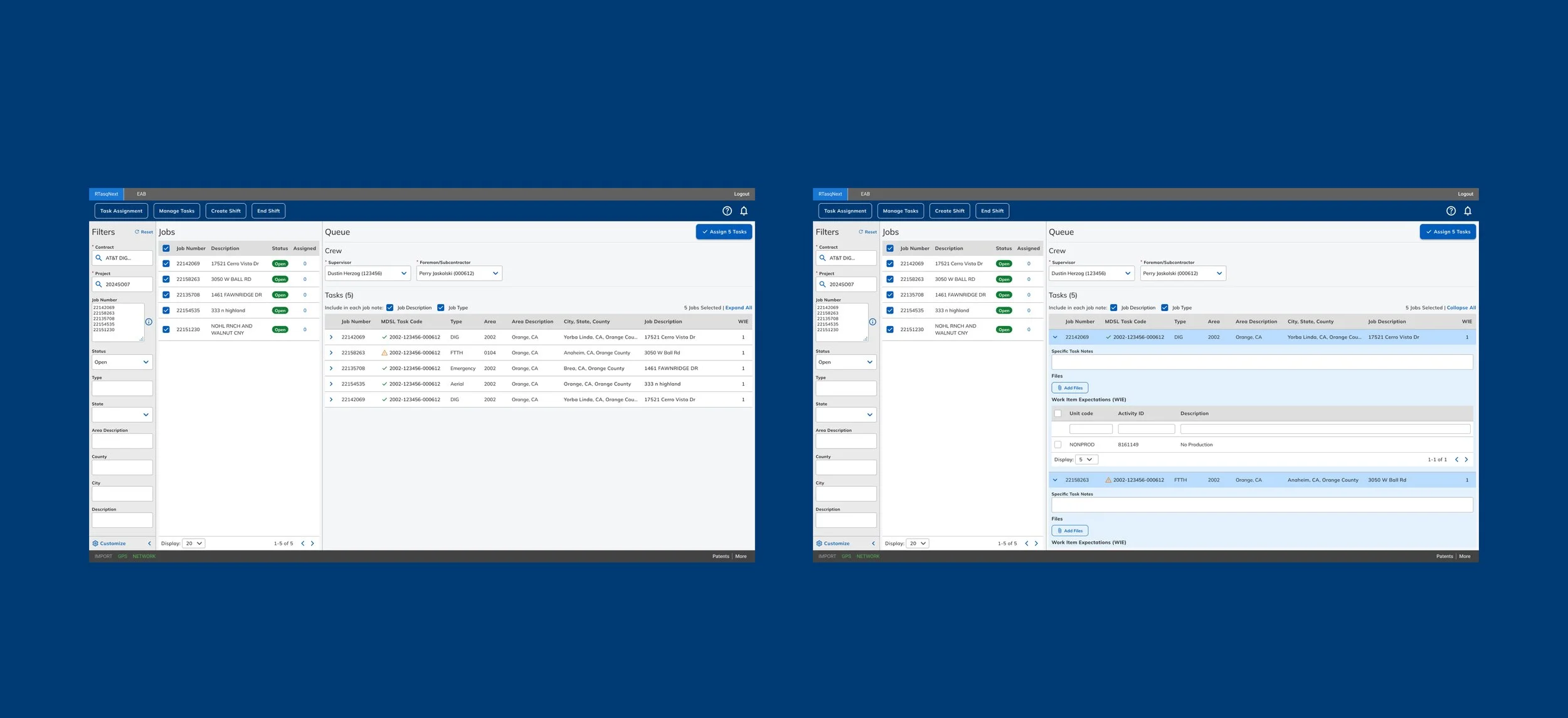Worker Activity - Supervisor Experience
Dycom Industries - UX Designer
Dycom Industries is a specialty contracting company that designs, builds, and maintains telecommunications and utility infrastructure across the United States, including fiber networks, wireless systems, and underground utilities.
Task: Redesign bulk task assignment portal based on user feedback while taking into account business requirements.
Team: Worked as the UX Designer alongside a team of Designers, Business Analyst, UX Researchers, and Developers.
Duration: August - November 2024
Tools: Figma, Dovetail, Jira
Used with permission. ©Dycom Industries 2025
🌟 Goals of the Redesign
The old interface was functional, but users told us it often felt like “too much on one screen.” Our redesign focused on creating clarity and speed without sacrificing detail.
Reduce cognitive load → By streamlining layouts and standardizing components, we aimed to make the interface feel less overwhelming and more intuitive.
Improve task assignment speed → Supervisors needed to move fast. We designed workflows that minimize clicks and surface the right information at the right time.
Make job and task details easier to scan → Key identifiers like job number, address, and task status were redesigned for quick recognition at a glance.
Ensure critical information is accessible → Crew roles, files, and work items were restructured into expandable sections, so users see what they need immediately—without wading through unnecessary layers.
Let’s set some goals!
The primary objective of the redesign is to enhance the usability and efficiency of the Axiom Medical Client Portal Dashboard, ensuring a seamless experience for both employers and employees of our clients. The redesign will focus on optimizing key features, streamlining data accessibility, and improving overall user satisfaction with utilizing the portal.
A little research can go a long way!
With the short timeline, I conducted a quick competitive analysis which is crucial in gaining insights and understanding the user experience landscape. One effective approach is diving into what users have to say about competitors through their app reviews. By analyzing these user-generated opinions, I was able to uncover valuable information about strengths, weaknesses, and user preferences. This process unveiled hidden opportunities, helps identify gaps in the market, and informs decision-making for creating superior user experiences that truly resonate with our customers.
outdated, overwhelming, lacking personalization
New designs, new features
The redesigned client portal introduces a set of innovative features that align with the current design and business direction, with a focus on enhancing user transparency and creating a user-friendly experience. By incorporating these features, users gain increased access to their information and reporting, enabling them to stay informed and in control. Simultaneously, the redesigned dashboard instills a sense of trust and empowers users with educational elements, providing guidance and insights to navigate the platform effortlessly. This approach ensures that users not only have greater transparency into their data but also feel supported and empowered, fostering a strong sense of trust and satisfaction within the client portal.
If only there was more time on this project
Time constraints won this time but…
Given more time on the UX/UI redesign project, I would have seized the opportunity to conduct a more comprehensive analysis of our competitors. This would involve delving deeper into their design strategies, feature sets, and user feedback. By gathering a broader range of information, we could gain valuable insights into industry best practices and identify potential areas for differentiation and improvement.
Furthermore, I would have loved to gather more feedback from our current users regarding their experiences with the existing client portal. This could have involved conducting additional user interviews, surveys, or usability tests to gain a deeper understanding of their preferences, pain points, and specific features they would like to see in the redesign. This user-centric approach would provide valuable insights for prioritizing design enhancements and aligning the redesign more closely with user needs and expectations.
By conducting a more in-depth analysis of our competitors and gathering extensive feedback from our users, we would have been able to further refine and enrich the redesign process, ensuring that our final product is not only aligned with business objectives but also delivers an exceptional user experience that surpasses expectations.

